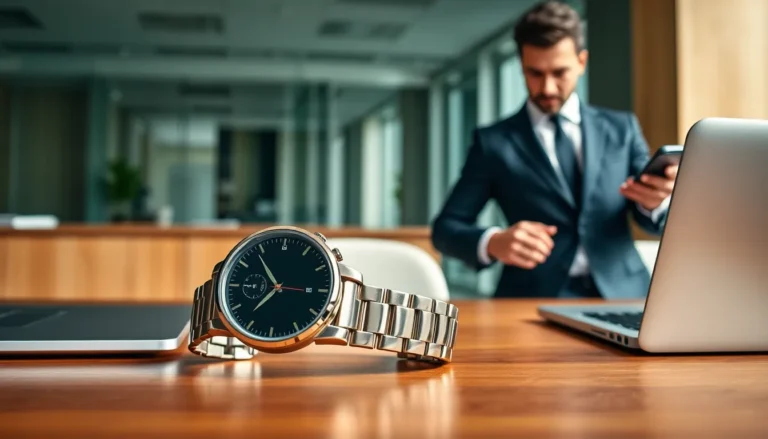In a world where screens are practically glued to our faces, eye strain has become the unwelcome guest at the digital party. If your eyes are feeling like they just ran a marathon after scrolling through your iPhone, it’s time to take action. Luckily, turning off that pesky eye strain doesn’t require a degree in rocket science—just a few taps on your device.
Imagine this: you’re binge-watching your favorite show or scrolling through social media, and suddenly, your eyes start to feel like they’re in a wrestling match. Fear not! With a few simple adjustments, you can transform your iPhone into a cozy haven for your peepers. Let’s dive into how to banish eye strain and keep your vision as sharp as your wit.
Table of Contents
ToggleUnderstanding Eye Strain
Eye strain, often referred to as digital eye strain, occurs when you focus on screens for extended periods. Frequent interactions with devices like iPhones can cause discomfort and fatigue for the eyes.
What Is Eye Strain?
Eye strain refers to the physical discomfort experienced from prolonged screen time. Activities like reading or watching videos can lead to overexertion of the eye muscles. This condition typically arises from factors such as glare, poor lighting, and improper viewing distances. With the increase in mobile device usage, understanding eye strain’s implications becomes crucial. The American Optometric Association emphasizes the need for awareness regarding screen-related eye discomfort.
Common Symptoms of Eye Strain
Symptoms of eye strain can vary significantly among individuals. Many people experience dry eyes, blurred vision, and headaches after prolonged device use. Others may notice difficulty focusing or increased sensitivity to light. These symptoms often worsen during activities that require visual concentration. Recognizing these signs is essential in addressing the issue effectively. Regular breaks and proper screen settings can mitigate these effects and enhance visual comfort.
Features on iPhone to Reduce Eye Strain
iPhones come equipped with features designed to alleviate eye strain during extended use. These tools help improve visual comfort and promote healthier screen habits.
Night Shift Mode
Night Shift Mode reduces blue light exposure during evening hours. This feature automatically adjusts the display’s color temperature to warmer tones, making it easier on the eyes. Users can schedule Night Shift to activate at sunset or customize it based on personal preferences. Engaging this mode promotes better sleep quality by minimizing blue light that can interfere with melatonin production. Accessing this feature is simple, requiring users to navigate to Settings, then Display & Brightness, and select Night Shift.
True Tone Display
True Tone Display enhances visual comfort by adjusting screen colors based on ambient lighting conditions. This technology ensures that whites appear consistent in various light environments, reducing glare and blue light strain. Users enjoy a more natural viewing experience as the screen adapts to surrounding light levels. Activating True Tone is straightforward; users can find the option in the Display & Brightness section of Settings. Employing this feature fosters a seamless visual transition, making screen time less taxing on the eyes.
Increasing Text Size
Increasing text size improves readability and decreases eye strain. Users can adjust text size by navigating to Settings, selecting Display & Brightness, and adjusting the Text Size slider. Larger text enhances visibility, making it easier to read without squinting. Additionally, using Bold Text further amplifies clarity. These adjustments allow users to customize their reading experience, promoting comfort during extended screen time. Adopting these settings significantly enhances legibility in various applications and content, providing a more comfortable viewing experience.
Steps to Turn Off Eye Strain on iPhone
Adjusting various settings on an iPhone can significantly reduce eye strain. Simple changes enhance user comfort during prolonged screen usage.
Adjusting Brightness Settings
Adjusting brightness settings helps tailor screen visibility to current lighting conditions. Lower brightness reduces glare, easing the strain on the eyes. Users can manually set brightness in Settings > Display & Brightness. Automatic adjustments based on ambient light can also be enabled. This feature allows the iPhone to adapt brightness according to surrounding conditions, making the screen easier on the eyes.
Enabling Dark Mode
Enabling Dark Mode offers a more comfortable viewing experience, especially in low-light environments. Dark Mode changes the overall interface to darker colors, which reduces eye strain by minimizing glare. It can be activated in Settings > Display & Brightness or via Control Center. Users might notice a significant improvement in comfort during evening hours with this setting. Overall, Dark Mode not only benefits the eyes but also conserves battery life.
Turning Off Notifications
Turning off notifications decreases interruptions and overall screen time. Unwanted notifications can lead to increased eye strain from frequent screen checks. Users can customize notification settings by navigating to Settings > Notifications. Each app listed allows for granular control over how and when notifications appear. Reducing notifications leads to less screen engagement, freeing up time without compromising comfort.
Additional Tips for Reducing Eye Strain
Eye strain can greatly affect comfort and productivity. Implementing a few more strategies enhances relief from discomfort while using an iPhone.
Taking Regular Breaks
Frequent breaks reduce eye strain significantly. The 20-20-20 rule proves effective: every 20 minutes, look at something 20 feet away for at least 20 seconds. Setting a timer makes it easy to remember to take those breaks. Using these short pauses allows the eyes to rest and shift focus, minimizing fatigue. Incorporating movement during breaks, such as stretching, also helps improve circulation. Extended focus on the screen leads to discomfort, and regular breaks address this concern.
Proper Lighting Conditions
Optimal lighting has a crucial role in reducing eye strain. Natural light is preferable; it provides better visibility and reduces glare from screens. Adjusting surrounding lighting can also help; use soft, indirect light instead of harsh overhead lighting. Positioning screens to avoid reflections makes a significant difference. Dimming screen brightness in low-light situations enhances comfort without putting unnecessary strain on the eyes. These adjustments not only create a pleasant environment but also contribute to better visual health.
Eye strain doesn’t have to be an inevitable part of using an iPhone. By making a few simple adjustments to settings and habits, users can significantly improve their comfort during screen time. Utilizing features like Night Shift Mode and True Tone Display can enhance the viewing experience while decreasing the risk of discomfort.
Incorporating regular breaks and optimizing lighting conditions further supports eye health. With these strategies in place, it’s possible to enjoy the benefits of technology without the drawbacks of digital eye strain. Prioritizing visual comfort leads to a more enjoyable and productive experience on the device.


